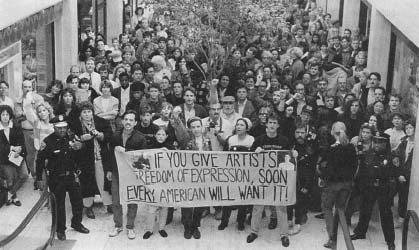Mapplethorpe Obscenity Trial: 1990
Obscenity Or Art?
The trial began on September 24, 1990, before a jury of four men and four women with Judge F. David J. Albanese presiding. The lawyers for CAC and Barrie were Marc D. Mezibov and H. Louis Sirkin. The prosecutors were Richard A. Castellini, Frank H. Prouty, Jr., and Melanie J. Reising.
The prosecutors had to convince the jury that the seven pictures were legally obscene, as "obscene" was defined by the Supreme Court in the 1973 case Miller v. California. Miller says that material is obscene only if: (1) the average person, applying contemporary community standards, would find that the material as a whole appeals to the prurient interest; (2) the material depicts or describes sexual conduct in a patently offensive way; and (3) the material, as a whole, lacks serious literary, artistic, political or scientific value.
 Following the jury's verdict of "pandering obscenity," hundreds of protesters demonstrated outside the Cincinnati Arts Center.
Following the jury's verdict of "pandering obscenity," hundreds of protesters demonstrated outside the Cincinnati Arts Center.
Both the prosecution and the defense wanted Albanese, rather than the jury, to make the decision on particular elements of the Miller test. Prosecutor Prouty argued that Albanese should determine what community standards were:
We're not required to show community standards 6ecause the court [Albanese] becomes the community.
For the defense, Mezibov argued that Albanese and not the jury should decide whether the pictures had serious artistic value:
It would be inappropriate, it would be wrong, I submit, for lay people to guess and to speculate as to what constitutes serious artistic value.
Albanese, however, decided to leave all three elements of the Miller test to the jury, holding that, "The court will not substitute its judgment for that of the jury."
To prove the defense's claim that the seven pictures had serious artistic value, therefore, Mezibov and Sirkin brought in several art experts to testify. The art experts called the pictures the work of "a brilliant artist," with "symmetry" and "classic proportions."
On October 5, 1990, the eight jurors found CAC and Barrie not guilty of the charges of displaying obscene material. Under Ohio law, the case ended then and there, because the state is prohibited from appealing a jury verdict. Although CAC and Barrie were vindicated, the victory was expensive: The trial cost CAC over $200,000 in costs and attorneys' fees.
The acquittal of the Mapplethorpe defendants reaffirmed the obscenity principles of Miller v. California and the protection of the First Amendment in a new area. This new area was the field of gay rights and the right of homosexual artists to express themselves. As Mezibov said after the trial:
Yes, we have a Bill of Rights. But it's meaningless unless you fight for it.
—Stephen G. Christianson
Suggestions for Further Reading
Cembalest, Robin. "Who Does it Shock? Why Does it Shock?" Artnews (March 1992): 32-33.
—. "The Obscenity Trial: How They Voted to Acquit." Artnews (December 1990): 136-141.
Gurstein, Rochelle. "Current Debate: High Art or Hard-Core? Misjudging Mapplethorpe: the Art Scene and the Obscene." Tikkun (November-December 1991): 70-80.
Light, Judy. "Jury Acquits Museum in Landmark Art Trial." Dancemagazine (December 1990): 12-13.
Merkel, Jayne. "Art on Trial." Art in America (December 1990): 41-46.
Parachini, Allan. "Year of the Censor: How Photography Became the Focus of Fear and Loathing." American Photo (November-December 1990): 39-42.
Additional topics
Law Library - American Law and Legal InformationNotable Trials and Court Cases - 1989 to 1994Mapplethorpe Obscenity Trial: 1990 - Obscenity Or Art?, Suggestions For Further Reading